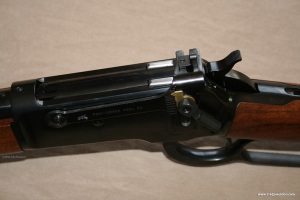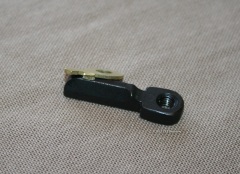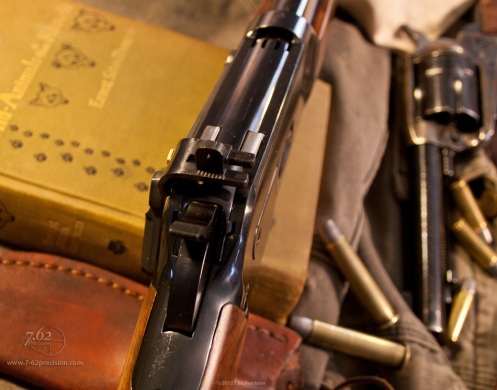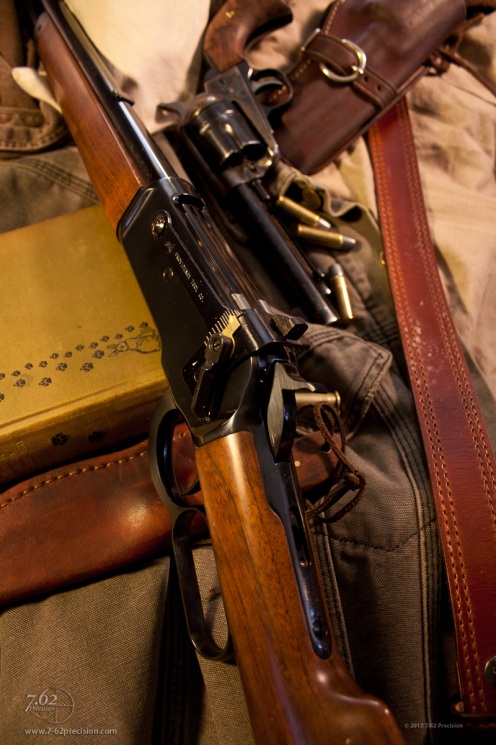Providence Tool Company Pattern 21 Sight
A while back I bought a .45-70 Winchester/Miroku 1886 Extra Lightweight rifle. I was in town only for a couple days between remote jobs, so I grabbed the rifle and a modern Lyman #66 receiver sight and headed back out to the bush. Since then, that ’86 rifle has worn the Lyman 66 sight, which was an annoyance to me, because as much as I love the Lyman receiver sights, I am a bit of a traditionalist, and it just wasn’t right for that rifle.
Now my purpose for the rifle is for bear protection, for hunting, and for the enjoyment of owning and shooting a fine lever-action rifle. For hunting or bear protection, the Lyman receiver sight was fine. For my enjoyment of the rifle, it was not. A tang sight would be great for target shooting, would work ok for hunting, and satisfy the traditionalist in me, but they tend to be more easily damaged, and this was a rifle that I planned to have beating around with me in the bush. I wanted a stronger type of sight that would be there when I needed it, but something that was period-correct for the 1886 Winchester.
 Back in 1895 Winchester was introducing a new rifle. It had a long bolt that knocked tang sights over like bowling pins. Lyman designed a type of sight to go with the then new 1895 Winchester rifle. The Lyman Model 21 sight attached solidly to the frame of the rifle and allowed easy, fast adjustment for rainbow trajectories common with the cartridges of the day. This was just the sight that I needed for my 1886! The sight just looks right on the long frames of the 1886, and especially the 1895 Winchesters. It is a strong, simple design and provides easy elevation adjustments for longer hunting shots, yet the required ruggedness for daily carrying for bear protection. Lyman #21 (and 38) sights can still be found today, but if in good condition bring premium prices. I have seen them sold for as much as $500. I might purchase an original Lyman 21 sight for an original rifle, but I can’t justify the expense of putting an original sight on a new-production Winchester.
Back in 1895 Winchester was introducing a new rifle. It had a long bolt that knocked tang sights over like bowling pins. Lyman designed a type of sight to go with the then new 1895 Winchester rifle. The Lyman Model 21 sight attached solidly to the frame of the rifle and allowed easy, fast adjustment for rainbow trajectories common with the cartridges of the day. This was just the sight that I needed for my 1886! The sight just looks right on the long frames of the 1886, and especially the 1895 Winchesters. It is a strong, simple design and provides easy elevation adjustments for longer hunting shots, yet the required ruggedness for daily carrying for bear protection. Lyman #21 (and 38) sights can still be found today, but if in good condition bring premium prices. I have seen them sold for as much as $500. I might purchase an original Lyman 21 sight for an original rifle, but I can’t justify the expense of putting an original sight on a new-production Winchester.
So there I was stuck with a nice 1880s style rifle wearing a modern sight. You can imagine how pleased I was to discover that Providence Tool Company was building a close replica of the original Lyman 21 “Climbin’ Lyman” sight.
The Providence Tool Company Pattern 21 Sight can be ordered directly from Providence Tool Company (check out their Peabody rifles while you are on their site) or can be ordered online from Buffalo Arms.
 I ordered a Pattern 21 sight from Buffalo Arms on the recommendation of the guys at Providence Tool Co. The sight soon arrived packaged in a poly bag and included the parts of the sight itself, detailed instructions for installation and use, and quality drill bit and tap for drilling and tapping the receiver for the mounting screw and sight stud. If installing on an original Winchester 1895, the forward hole already exists with the correct threads. New Japanese built 1895 rifles have metric threading, so the forward hole can be simply rethreaded with the included tap. On 1886 Winchesters, new manufacture or original, both front and rear mounting holes will need to be drilled in the receiver. Any rifle previously drilled and tapped for a Lyman 21 sight will work with the Providence Tool Co. sight. If the original threads are poor, simply clean them up with the provided tap for installation of the new sight.
I ordered a Pattern 21 sight from Buffalo Arms on the recommendation of the guys at Providence Tool Co. The sight soon arrived packaged in a poly bag and included the parts of the sight itself, detailed instructions for installation and use, and quality drill bit and tap for drilling and tapping the receiver for the mounting screw and sight stud. If installing on an original Winchester 1895, the forward hole already exists with the correct threads. New Japanese built 1895 rifles have metric threading, so the forward hole can be simply rethreaded with the included tap. On 1886 Winchesters, new manufacture or original, both front and rear mounting holes will need to be drilled in the receiver. Any rifle previously drilled and tapped for a Lyman 21 sight will work with the Providence Tool Co. sight. If the original threads are poor, simply clean them up with the provided tap for installation of the new sight.
Providence Tool Co. also makes a shorter version of the sight for installation on ’92 and ’94 Winchesters, and a version for Marlin lever actions.
The sight is made of steel with a brass pointer. Two brass pointers of different thickness are included for correctly timing the locking lever. The steel is blued and can be used as is, or reblued, antiqued, or color case hardened to match the rifle or the look that you want. There is a faint mold mark on the locking lever, which I would probably remove if I was ever to refinish the sight for any reason.
The sight is adjustable for windage. I should probably say it can be set for zero, as it is held in place by a set screw and is not finger adjustable. If you want finger-adjustable windage, this modification could easily be done using parts from another type of receiver sight. This would make the sight more like a Lyman 38.
Installation
For installation I first disassembled the action. I probably could have found a way to drill the receiver with the action only partially disassembled, but I wanted to be able to easily clean the cuttings up so none remained in the action. I will post disassembly and reassembly instructions in another article, as I fixed
some major mistakes that Winchester made in building this rifle at the same time that I installed this sight. Instead of fixing these mistakes, Winchester gave them fancy names; rebounding hammer, and tang safety, and tried to pass them off to us as “improvements.”
Once the action was disassembled, I located the front screw hole by following the instructions from Providence Tool Co. I marked the location and then drilled the hole.
I tapped the hole and then installed the sight frame and front screw. Holding the sight with the forward screw centered in the slot, I used a flat feeler gauge to place the sight .015″ above the top of the bolt and marked the location for the rear hole. After drilling and tapping the rear hole, I cleaned up the inside of the receiver and then adjusted the length of the screws to prevent interference with the bolt. The screws should be flush with the inside of the receiver and the edges of holes should be cleaned up so no metal protrudes into the receiver due to drilling or tapping. This will allow the bolt to travel smoothly and easily.
The screws were adjusted for length, and the the sight was installed. Now I needed to fit the brass pointer. I first put each pointer in place on the sight stud and spun the locking lever tight. The thinner pointer left the locking lever pointing forward when tight, and the thicker one left it pointing back, but a little high, so I used a file and a pit of sand paper to thin it down a little. The pointer has a little tab that rides in a slot in the sight and keeps the pointer aligned with the elevation marks. The tab is not bent and is left long for easier bending. Placing the pointer in a vice with the tab sticking up above the edges of the vice jaws allows it to be easily bent to a 90 degree angle. Once this is done, the tab is filed down to the correct thickness and length to ride easily in its slot on the sight body.

Installing and checking function prior to using Loctite on the sight’s front screw and the sight stud.
Once the pointer was ready, I installed everything, checked function, and then removed and reinstalled the rear sight stud and front screw using some Loctite to prevent vibration from loosening them. Any time you are shooting or carrying a firearm on a snow machine, four-wheeler, airplane, or other vehicle, there is a good possibility that screws will begin to back out.
I did not put locktite on the windage set screw yet because the rifle needs to be zeroed first. I plan to zero the sight at various ranges, taking a photo of each range setting, and then make range marks for each position by using a center punch to mark small dots on the sight.
The finished result looks great. It looks correct for the rifle, and the sight is solid. Installation was easy and the included tooling meant I did not have to look for a bit and tap. It is quick and intuitive to use. I am very pleased with the results.
The Providence Tool Company Pattern 21 sight is slightly different than the original Lyman 21. It is a bit simpler and uses fewer parts through a more efficient design. Some may feel that it is not close enough to the original sight, but I think it looks great, especially on a modern 1895 or 1886 rifle. If you are looking for total authenticity, get an original Lyman, of course. Still, I have seen varied examples of period gunsmith-made copies of Lyman 21 sights, so even with the small changes from the original and the Providence name on the side, this sight can look very correct on an original rifle.
If you have a lever action rifle that has been drilled for a side scope mount, this sight can also help cover the unsightly scope mount holes – a much more economical way to deal with them than having each welded up and the receiver refinished. There are many 1886 and especially 1894 and 1895 rifles out there that have been drilled for scope mounts, and the results can be pretty ugly on an otherwise nice looking rifle.
If you want the advantages of a receiver sight on an traditional-style lever action (or even a single-shot rifle), but do not want a blocky, modern-looking sight, I suggest that you seriously consider the Providence Tool Company Pattern 21 Sight.












I have just sourced an original #21 sight for my Win m 1895 in 35 WCF. I get new casings from Bruce Bertram of Bertram Brass in Australia. I use Speer HotCor 250 gr bullets and IMR 3031, seems to recoil less than the 4895 powder but good velocity at 2300 fps with my crony. I can take longer shots past what a 405 can do and it retains more energy past 100 yds. I’ve had this rifle for 36 years and finally sourced another 1895 as a donor for a butt, mine was a recent 94 butt since the original had been cut short.
LikeLiked by 1 person
I have an original takedown model 1895 win in 30-06 1907 vintage with a climbin Lyman #21 sight,it appears to be factory installed and other than the MVA aperture sight I have in my Sharps 45-120 its the best peep sight you can put on any rifle.With my hand loads and a 110gn.sp bullet i can regularly bust beer cans at 300yds.If it had a windage adjustment on it I’d be inclined to say its the best rear sight I have ever used.
LikeLiked by 1 person
I love those original 1895s!
LikeLike
I have a fairly sizable Winchester lever gun collection and the one thing I’ve noticed is that when showing these lever guns to others they always seem to be overly fascinated with the 1895,it has something to do with the way the guts fall out and go back in when the lever is cycled,every one smiles wide when they open and close an 1895,they cant help it.
LikeLike
There was once an 1895 Winchester I wanted to buy, and I have kicked myself ever since for letting it go. It was a .30-40 Krag carbine, marked with US in a place I didn’t recognize. Little original finish but no rust or pitting, everything original, $725 in a local gunshop. Looked for information about the martial markings – wondered if the markings were fake, but they looked old. I looked at that rifle over and over for about a year, but money was tight, and then one day it was gone.
A few months later I learned what it was. It was one of the handful of 1895 Winchesters issued to the Alaska Territorial Guard during WWII (along with the more common 1903 Springfields) and then continued to serve with the Arctic Scouts into the Cold War.
I’ve looked for another one of those rifles ever since, but most were probably used until worn out, rusted irreparably, or lost somewhere along the West Coast of Alaska. I only know of one other, and don’t know where it is, only who used to own it.
LikeLike
Hello,
is it possible to buy this sight in France ?
I lose the sight of my Winch 1895.
Thanks
LikeLike
I would contact Providence Tool Company or Buffalo Arms and ask.
LikeLike
Great article. In it you mentioned mechanical problems (eg. rebounding hammer) with the 1895 that were covered up by the company. I have been trying for some time to find specific information on them and how to fix them. Could you direct me to a resource that will help me?
LikeLike
The rebounding hammer is not the problem with the 1895 as it was with the 1886. Some 1886s experience light strikes, and for a .45-70, that can be dangerous, as it is often used for dangerous game or bear protection.
1895 doesn’t have this problem in my knowledge, but is just a little more complicated than it needs to be, and the trigger is not as nice. I don’t like the tang safety, however, as it is dangerous to have a safety that allows the hammer to fall. If the hammer falls, your reflex is to treat it as a misfire, and you react accordingly instead of taking the rifle off safe. In a situation when you are facing an aggressive bear, for example, this could be a matter of survival.
On my 1886, I removed the hammer, trigger, safety, and all the extra fiddly bits associated. I replaced them with the simple hammer and trigger from a Browning-marked Miroku 1895 and that solved the issue. I don’t know if these Browning parts are still available anywhere.
I don’t know of any Browning parts available for the 1895, but I have both Browning and Winchester 1895 Miroku rifles, and I’m not sure the parts would simply drop in correctly from the Browning. The best thing to do may be to send it to the right smith who can alter the original hammer and strut and close the safety slot in the tang.
I just removed the safety on my Winchester, altered the half cock notch to the original configuration, and left the hammer rebounding. It now rebounds into a half-cock safety.
LikeLike
I have an original Win. 1895 in 30-06 with the Lyman #21 (climbin Lymin) sight,its probably the best sight that can be put on any firearm,I’m very pleased to see that they now make this same style sight for the 86,92,94 so I will probably be getting some from Prov.tool.
LikeLike
I have one of these for an original ’95 in 30 US. Pretty happy with it – except even with the rear sight fully depressed, the point of impact is way above point of aim.
No negative views on this product whatsoever, but now I guess I better get some stock, some files, and start making a higher front sight…
LikeLike
Solves the long range problem. Thanks
LikeLike
[…] The rear sight dovetail has a filler blank in it, and there is a Williams receiver sight mounted. It looks way too modern. The sight is in new condition and has no marks on it, so I will pull it off and sell it to partially fund a Lyman type 21 style sight. Since the originals are quite expensive, I will go with the Providence Tool Company reproduction, since the rifle is not an original rifle anyway. I have one on my 1886 Winchester and it is a great sight. […]
LikeLike
If you look at the list of Browning Patents from the period of his collaboration with Winchester you will clearly note a design sold to Colts and other automatic arms that were not built by Winchester. Browning’s relationship with Winchester was not that of an employee. The point is that the 1895 was designed by Browning and he in turn assigned to Winchester.
LikeLike
Well written report, except for the fact that it was JM Browning that designed the 1895, not Winchester! 🙂 Seriously, well done!
I’ve always liked the Lyman 21 / 38 and have used them on Origional 1886’s and 1895’s as well as Model 64’s. I think that they offer the finest sight picture of any reciever mounted sigh. My ’86 in .33WCF is still a favorite woods gun.
I am considering the Providence Tool Pattern 21 for a late 1970’s Marlin 1895S. Is there anything I should know in advance about pitfalls in mounting or usage of this sight on that rifle?
Is the Brass indicator available in any other color? Looks out of place to me… Lastly, will the sight function properly without the indicator?
Drew Perez
Buxton, Maine.
LikeLike
John Browning designed the 1895, but he was working for Winchester. Winchester wanted a rifle that would handle the more modern rounds that could not go in a tubular magazine.
I don’t mind the brass indicator (I like the contrast), but if you do not prefer the brass colour, there are products to blacken the brass, like Birchwood Casey Brass black, and even cold blue will blacken brass. It may function without the indicator, but the indicator is something I would definitely use, so I personally would not want to be without it. You could probably use a small washer in its place.
LikeLike
A small point, and not that it matters much, but I think you’ll find that JM Browning was granted the patent for the 1895 ( U.S. Pat No. 549,345) after designing it and then sold the design to Winchester. This was also true of the 1885, 1886, 1887 and many other popular rifles and shotguns which were also built by Remington, FN and Savage, sometimes simultaneously!
LikeLike
Yes, I am well aware of the history of John Browning’s relationship with Winchester. The terms of his employment by Winchester was that he would design firearms for them, and they would purchase the rights to the designs. He designed many more firearms that Winchester paid him for but never produced. This arrangement came to an end when Browning requested royalties for a design that he knew would be very successful, and Winchester refused in an obvious lapse of sanity. Still, the design 1895 rifle was specifically requested of John Browning by Winchester, who was his employer, so it is splitting hairs to try to separate the two at that time. It may not have been a traditional employment, but it was still employment by Winchester. Also, Winchester had a history of patenting their improvements or inventions under their inventor’s own names.
LikeLike
Dear sir,
I am the owner of Providence Tool Company, LLC and I would just like to thank you for this wonderful review. I just came across it the other day on ar15.com, I made an account on that website hoping to add some information, but it won’t allow me to, so I clicked on the link to this website, and voila, here I can. The link that you have to the website is not current, we now use
http://www.providencetoolcompanyllc.com
Thanks again for the great review of our Pattern 21 Sight 🙂
LikeLike
Thanks for posting. I love your sights and I am seriously coveting one of your rifles! I have the correct links in the review here, but unfortunately the post on AR15.com is archived, so I cannot change it there.
I will be buying more of these sights.
Feel free to post a link to this article on your website.
LikeLike
[…] is always this option. https://762precision.wordpress.com/pr…tern-21-sight/ "I come from a state that raises corn and cotton and cockleburs and Democrats, and […]
LikeLike
Opinion on sights 336 .35 Remington - Page 2 said this on 13 January 2013 at 4:44 am |